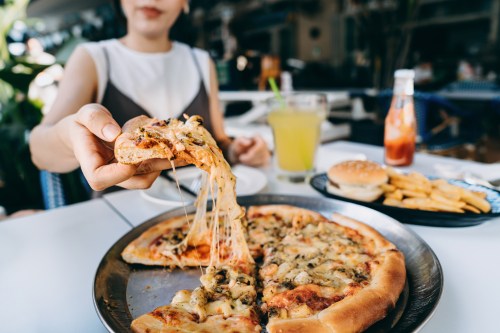In the ’90s, low-cal everything may have been the norm, but now healthy food habits have (thankfully) evolved far beyond that ethos. Instead of getting overly hung up on counting macronutrients and calories, many health coaches and registered dietitians preach other practices, such as incorporating veggies into half of every meal or letting your intuition guide what you eat.
Two other phrases you’ll often hear in relation to mindful eating: portion size and serving size. While they’re often used interchangeably, registered dietitian Carrie Dennett, RD says they have two completely different meanings—and knowing the difference plays an important role in staying healthy.
Portion size vs serving size: What’s the difference—and why does it matter?
It’s a subtle, but significant difference, says Dennett. “A serving size is the amount of food you’re served—whether it’s at a restaurant or to yourself at home—and a portion size is how much of that serving you actually eat.” To illustrate this, think for a minute to the huge plates of food served at Olive Garden or The Cheesecake Factory. (#TBT to when we all used to go out and eat.) A serving might be one of those massive plates of pasta—it’s what you were served, literally—but you might only eat half of that and save the other half, making your portion size different than the serving size.
It sounds straightforward enough, but Dennett says it can get tricky when you’re trying to follow set dietary guidelines and avoid nutritional gaps. “For a long time, the national guidelines referred to everything in terms of servings, but the average person didn’t actually know what a serving of fruit or a serving of whole grains, for example, actually was,” she says. It’s one thing to know to eat a certain number of servings per day, quite another to implement that when a serving of that food is unclear. (The current guidelines are more explicit, emphasizing number of cups.)
Want more nutrition label FAQ? Check out this guide from a top dietitian:
Interpreting recipes and food labels can cause some confusion too, Dennett says. “Both refer to number of servings it makes, but that may be different than what your portion ends of being, or in other words, how much you’re eating.” That frozen Trader Joe’s stir-fry might claim to make three servings, but if you’re super hungry (or just crushed a big workout), you may want more than just a third of the dish to stay full.
That’s why Dennett says that to her, portions are more relevant than serving size in meeting health goals. “Serving sizes are pretty set—whether you’re seeing them in terms of what you’re reading in a recipe or on a food label—but nutrient needs vary person to person, and that affects the portion size of their meals and snacks,” she says. Her best advice: Use serving sizes as a general guide, but go bigger or smaller when it comes to your portion sizes, depending on what your individual health needs are.
Where label reading comes in
That’s not to say that serving sizes are worthless; Dennett says they can be a good starting point (since they’re designed for the average person). A serving of protein (whether it’s meat or plant-based) is typically thought of as the size of a deck of cards. The national health guidelines also recommend the average person eat one cup of fruit, one to three cups of vegetables, and between three to eight ounces of grains a day.
That said, Dennett warns that serving sizes on nutritional panels (not the ones set in the dietary guidelines) can sometimes be misleading. “I’ve seen some labels for bread that count one slice as two servings, which doesn’t really make sense when you think about how we eat bread,” she says. “I’ve also seen some brands list their serving size as half a cup, when it’s more likely for someone to eat double the amount,” she says. Brands have traditionally done this as a way to trick consumers into thinking their foods are low-sugar or low-sodium.
Using serving and portion sizes to guide what you eat isn’t at odds with mindful eating, BTW. Especially if you struggle with interpreting your body’s signals of what and how much to eat, they can be especially useful. Just think of them as another tool in your wellness toolbox, there if and when you need it.
Sign Up for Our Daily Newsletter
Get all the latest in wellness, trends, food, fitness, beauty, and more delivered right to your inbox.
Got it, you've been added to our email list.











